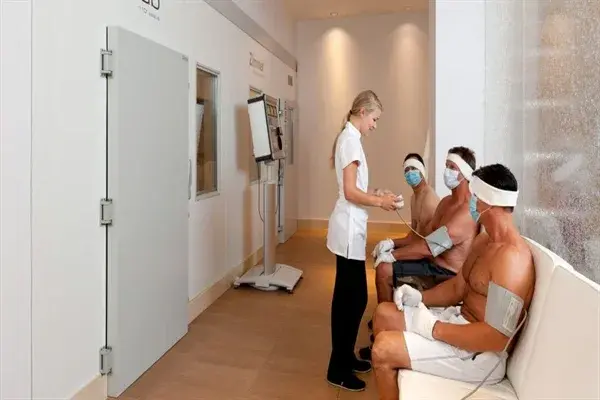Cryotherapy: What Happens When You Freeze Your Butt Off (For Wellness)
- Jenn's Picks

- Jul 14
- 3 min read
Updated: Jul 17

When I pictured myself trying whole-body cryotherapy, I imagined it would be like something out of a sci-fi movie. Spoiler: it kind of was.
With the guidance of some very chill health professionals, I stepped into a multi-chambered Cold Chamber experience that promised to give my nervous and circulatory systems a boost — and maybe even leave me feeling rejuvenated.
Let me set the scene: I was on vacation and managed to squeeze in one session (though regular treatments are recommended for long-term benefits). Before stepping in, we had to fill out a health form to make sure we were good candidates. This isn't your average wellness treatment — they take safety seriously here.
Once suited up in a bathing suit (yes, just a bathing suit), plus shoes, socks, gloves, a headband, and face covering, our group entered the first chamber. From there, it was a carefully orchestrated dance: door closes, next one opens, repeat. The second room was -60°C — just a warm-up for the final chamber, a dry cold environment set to -110°C.
We were told to keep moving so our skin wouldn’t freeze, but not to move too quickly or we'd create wind and make it feel colder. No pressure.
To make things a little lighter (or maybe more surreal), we picked a song to accompany our three-minute plunge into the deep freeze. Our group chose Bob Marley’s “Three Little Birds” — which I now permanently associate with walking in slow-motion circles in sub-zero temperatures, trying not to panic, singing “everything’s gonna be alright” through chattering teeth.
I’ll admit: I didn’t exactly love it in the moment. I wasn’t sure if I was moving right, and there was a tiny part of me wondering if I was going to make it out in one piece. But walking out the other side? Thrilling. Like I had done something bold and bizarre that most people I know wouldn’t try. (Which is kind of what I love to do.)
Afterward, we were led to a quiet relaxation room and told to let our bodies come back to temperature naturally. That post-cryo rest? Legitimately blissful. My body felt like it had been through something important. My nervous system, strangely... settled.
Would I do it again? Absolutely — especially now that I know what to expect. I imagine with a few more sessions, I’d stop worrying about freezing and start focusing on the actual benefits.
So what are the benefits of whole-body cryotherapy?
Cryo treatments originated in Japan in the late 1970s, initially to treat pain from rheumatoid arthritis. Since then, it’s been adopted in sports medicine, wellness circles, and even beauty clinics for its potential wide-reaching benefits:
Reduced inflammation and pain – Especially helpful for athletes or people with joint and muscle conditions.
Improved circulation – Blood vessels constrict in the cold and dilate after, boosting blood flow.
Elevated mood and energy – Cold exposure stimulates endorphins and norepinephrine.
Faster muscle recovery – Many report reduced soreness post-workout.
Support for metabolism and immunity – Early studies suggest a potential role in increasing metabolic rate and resilience to stress, though research is still growing.
What to look for when choosing a Cryo Cold Chamber
Cryotherapy involves extreme cold — so safety is key. Here's what to look for:
Professional Supervision: Make sure a trained team is monitoring the chamber at all times. Ideally, there should be staff both outside and inside during your session.
Pre-Treatment Screening: You should be asked to fill out a health questionnaire to identify any contraindications (e.g., heart conditions, circulatory issues).
Proper Gear: You should be provided with protective gear for hands, feet, ears, mouth, and sensitive areas.
Multi-Chamber System: The safest setups include a series of rooms (e.g., -10°C → -60°C → -110°C) to help your body acclimate gradually.
Emergency Protocols: They should have clear procedures for exiting the chamber if needed.
While there’s no single global governing body for cryotherapy, providers should follow local regulations and safety guidelines. In some countries (including Canada and the U.S.), cryotherapy is not regulated as a medical treatment, so it’s extra important to go to reputable wellness clinics that are transparent about their protocols, staff training, and equipment standards.
Summary
This was definitely one of the most extreme treatments I’ve tried — and I mean that both literally and emotionally. The thrill of doing something unfamiliar, the quiet regulation afterward, and the confidence boost of trying something outside my comfort zone made this one memorable.
Here’s the quick rundown:
Clothed: Bathing suit + protective socks, shoes, gloves, headband, and face mask
Physical touch: No — fully individual experience inside the chamber
Best for: People looking to reduce inflammation, improve mood/circulation, or try something truly out-of-the-box
Safety Tip: Choose a provider that prioritizes safety, screening, and supervision
Would I go again? Yes — and I’d pick the same song





Comments